View in other NatureServe Network Field Guides
NatureServe
Montana
Utah
Wyoming
Idaho
Wisconsin
British Columbia
South Carolina
Yukon
California
New York
Subalpine Mountainsnail - Oreohelix subrudis
Other Names:
Helix subrudis, Helix cooperi, Pyramidula strigosa cooperi
Native Species
Global Rank:
G5
State Rank:
S5
Agency Status
USFWS:
USFS:
BLM:
External Links
General Description
Highly variable in form. Medium-sized to large, the diameter ranges from 11 to 23 mm, but usually more than 15 mm (new-born young about 2 or 3 mm diameter), and from 8 to 18 mm in height, depending on subspecies and local conditions. Typically heliciform to almost bee-hive shaped, with up to 6 whorls; the periphery is weakly angular. Umbilicus is narrow and deep, the aperture ovate to rounded, slightly thickened inside. Shell opaque and chalky, color pale gray to brownish (dead shells may be white), with a series of reddish-brown spiral bands, typically one on the upper surface and another just below the periphery, sometimes with one or more fainter bands below that. Shell surface with coarse irregular axial riblets and striae, sometimes with faint spiral sculpting (Hendricks 2012, Burke 2013). Internal anatomy is described by Pilsbry (1939).
Subspecies: O. s. subrudis, O. s. apiarium, O. s. limitaris; O. s. apiarium and O. s. limitaris may be synonyms.
Diagnostic Characteristics
Medium to large size, calcareous whitish to gray (some may be brownish), moderately elevated spire (sometimes almost bee-hive shape), variable banding, relativley narrow umbilicus, absence of refelcted lip, and surface sculpture help distinguish this from most other larger shells. Typical O. strigosa has a lower spire and larger umbilicus, O. yavapai has a much flatter profile, broader umbilicus, an obvious keel, and oblique and oval aperture.
Species Range
Montana Range
Range Descriptions
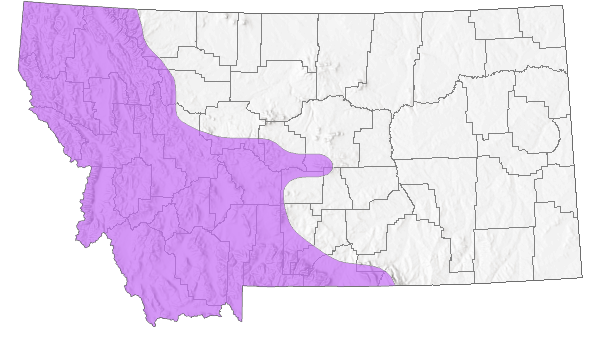
 Native
Native
Range Comments
Western North America, from British Columbia and Alberta south through Washington, Idaho, and Montana to Arizona and New Mexico. In Montana, reported on both sides of the Continental Divide from 21 counties. Elevation range is 838 to 2313 m (2750 to 7590 ft). May be abundant at some locations; as many as 60 live animals and 75 shells were reported at site in Gallatin County (Hendricks 2012). Oreohelix subrudis apiarium was described originally from specimens collected in 1916 along McDonald Creek in Glacier National Park (Berry 1919).
Observations in Montana Natural Heritage Program Database
Number of Observations: 147
(Click on the following maps and charts to see full sized version)
Map Help and Descriptions
Relative Density
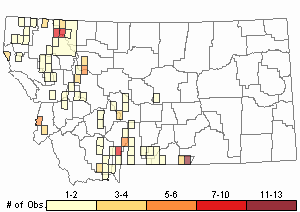
Recency
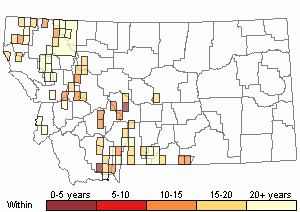
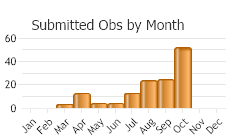
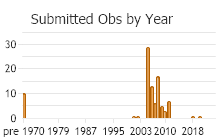
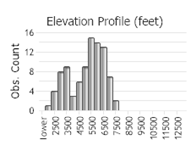 (Observations spanning multiple months or years are excluded from time charts)
(Observations spanning multiple months or years are excluded from time charts)
Habitat
Often in relatively moist sites, along stream courses and near seeps or springs, sometimes in talus slopes. Canopy species include western red-cedar, western hemlock, Douglas-fir, Engelmann spruce, ponderosa pine, limber pine, black cottonwood, aspen, paper birch, alder, willow, and rocky mountain juniper. Live animals present mostly in leaf litter, and under downed wood, rocks, and in duff or soil accumulations under wood and rocks; sun-bleached shells may be found on the surface (Berry 1919, Beetle 1987, Hendricks 2012).
References
- Literature Cited AboveLegend:
 View Online Publication
View Online Publication Beetle, D.E. 1987. The genus Oreohelix (Pulmonata: Oreohelicidae) in two western canyons of the Big Horn Mountains, Wyoming. Festivus 19(7):66-72.
Beetle, D.E. 1987. The genus Oreohelix (Pulmonata: Oreohelicidae) in two western canyons of the Big Horn Mountains, Wyoming. Festivus 19(7):66-72. Berry, S.S. 1919. Mollusca of Glacier National Park, Montana. Proceedings of the Academy of Natural Sciences of Philadelphia 71:195-205.
Berry, S.S. 1919. Mollusca of Glacier National Park, Montana. Proceedings of the Academy of Natural Sciences of Philadelphia 71:195-205. Burke, T. E. 2013. Land snails and slugs of the Pacific Northwest. Corvallis, OR: Oregon State University Press. 344 p.
Burke, T. E. 2013. Land snails and slugs of the Pacific Northwest. Corvallis, OR: Oregon State University Press. 344 p. Hendricks, P. 2012. A Guide to the Land Snails and Slugs of Montana. A report to the U.S. Forest Service - Region 1. Montana Natural Heritage Program, Helena, MT. vii + 187 pp. plus appendices.
Hendricks, P. 2012. A Guide to the Land Snails and Slugs of Montana. A report to the U.S. Forest Service - Region 1. Montana Natural Heritage Program, Helena, MT. vii + 187 pp. plus appendices. Pilsbry, H.A. 1939. Land Mollusca of North America (North of Mexico), Volume 1, Part 1. Monograph of the Academy of Natural Sciences of Philadelphia Monograph Number 3 (1): 1-573.
Pilsbry, H.A. 1939. Land Mollusca of North America (North of Mexico), Volume 1, Part 1. Monograph of the Academy of Natural Sciences of Philadelphia Monograph Number 3 (1): 1-573.
- Additional ReferencesLegend:
 View Online Publication
View Online Publication
Do you know of a citation we're missing? Beetle, D. E. 1961. Mollusca of the Big Horn Mountains. The Nautilus 74:95-102.
Beetle, D. E. 1961. Mollusca of the Big Horn Mountains. The Nautilus 74:95-102. Beetle, D.E. 1989. Checklist of recent Mollusca of Wyoming, U.S.A. The Great Basin Naturalist 49(4):637-645.
Beetle, D.E. 1989. Checklist of recent Mollusca of Wyoming, U.S.A. The Great Basin Naturalist 49(4):637-645. Beetle, D.E. 1997. Recolonization of burned aspen groves by land snails. Yellowstone Science 5 (summer):6-8.
Beetle, D.E. 1997. Recolonization of burned aspen groves by land snails. Yellowstone Science 5 (summer):6-8. Elrod, M.J. 1903b. Montana shells - Pyramidula strigosa [Oreohelix alpina]. The Nautilus 17:1-6.
Elrod, M.J. 1903b. Montana shells - Pyramidula strigosa [Oreohelix alpina]. The Nautilus 17:1-6. Forsyth, R.G. 2004. Land snails of British Columbia. Royal British Columbia Museum: Victoria, British Columbia, Canada. 188 pp.
Forsyth, R.G. 2004. Land snails of British Columbia. Royal British Columbia Museum: Victoria, British Columbia, Canada. 188 pp. Hammer, W.P. and R.B. Brunson. 1975. Fluoride accumulation in the land snail Oreohelix subrudis from western Montana. The Nautilus 89:65-68.
Hammer, W.P. and R.B. Brunson. 1975. Fluoride accumulation in the land snail Oreohelix subrudis from western Montana. The Nautilus 89:65-68. Henderson, J. 1936. Mollusca of Colorado, Utah, Montana, Idaho, and Wyoming, supplement. University of Colorado Studies 23(2): 81-145.
Henderson, J. 1936. Mollusca of Colorado, Utah, Montana, Idaho, and Wyoming, supplement. University of Colorado Studies 23(2): 81-145. Linscott, T.M., K. Weaver, V. Morales, and C.E. Parent. 2020. Assessing species number and genetic diversity of the Mountainsnails (Oreohelicidae). Conservation Genetics 21:971-985.
Linscott, T.M., K. Weaver, V. Morales, and C.E. Parent. 2020. Assessing species number and genetic diversity of the Mountainsnails (Oreohelicidae). Conservation Genetics 21:971-985. Russell, L.S. 1951. Land snails of the Cypress Hills and their significance. The Canadian-Field Naturalist 65:174-175.
Russell, L.S. 1951. Land snails of the Cypress Hills and their significance. The Canadian-Field Naturalist 65:174-175. Russell, R.H. and R.B. Brunson. 1967. A check-list of molluscs of Glacier National Park, Montana. Sterkiana 26:1-5.
Russell, R.H. and R.B. Brunson. 1967. A check-list of molluscs of Glacier National Park, Montana. Sterkiana 26:1-5. Vanatta, E.G. 1914. Montana shells. Proceedings of the Academy of Natural Sciences of Philadelphia 66:367-371.
Vanatta, E.G. 1914. Montana shells. Proceedings of the Academy of Natural Sciences of Philadelphia 66:367-371.
- Web Search Engines for Articles on "Subalpine Mountainsnail"
- Additional Sources of Information Related to "Snails / Slugs"





